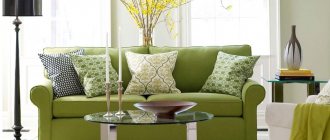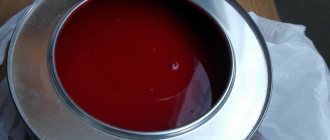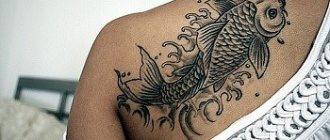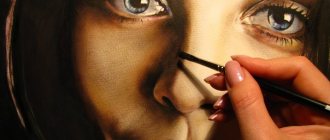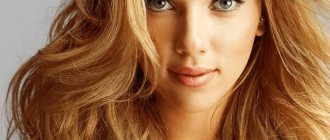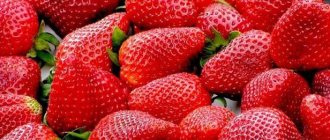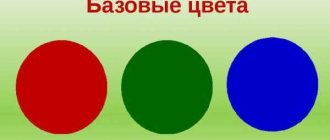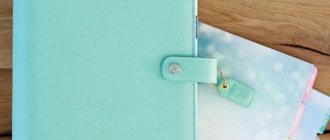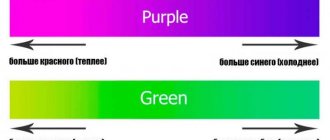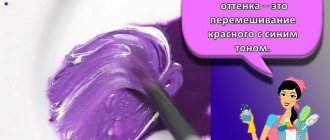What colors do you mix to get purple?
The "secret" to getting a beautiful purple is to use those shades of red and blue that are closest to each other and to violet on the color wheel. The purest violet is obtained by mixing red kraplak and ultramarine.
Interesting materials:
How to connect the Internet from phone to phone? How to connect jabra to android phone? How to connect a Chinese bluetooth earphone to your phone? How to connect a keyboard and mouse to your phone? How to connect a keyboard to an iPhone? How to connect a jbl speaker to a phone via bluetooth? How to connect a speaker to a phone via headphones? How to connect a speaker to a phone via Bluetooth? How to connect a Sony speaker to a phone via Bluetooth? How to connect your computer to the Internet via your phone?
Mixing rules
You can mix brown in different ways and there are more of them than with other colors, since in the process you can use a large number of additional colors without losing the main tone:
- yellow;
- blue;
- red;
- white;
- black.
It is easy to obtain new shades by mixing paints, since brown reacts well to new components, and the human eye can easily recognize many shades of this color.
You can mix brown using 2 or 3 shades of primary and secondary colors
You can mix brown using different combination formulas:
- Mix green with red dye. They try not to use dark versions of the original paints, otherwise the shade of brown becomes close to black.
- Combine yellow, red and blue colors. The method is similar to the previous one, since green consists of blue and yellow. This formula is convenient to use if your palette is out of green paint. When combining 3 or more colors, the finished mixture loses saturation.
- Combine orange with gray or black. Blue is more often found as a ready-made dye in a ready-made palette, so pairing with it is more common.
- Mix purple and yellow. This method is less popular due to the difficulty of maintaining proportions. If it is violated, the shade changes greatly.
The process of mixing paints to obtain brown involves a number of rules.
- To mix a certain tone of paint, exact proportions are observed.
- You can control the change in tone while mixing. To do this, additional colors are added gradually and little by little, otherwise the mixture turns out to be dirty.
- When the shade is ready, it is first tested on the surface that is going to be painted. Color may change on different surfaces or after drying.
- Some types of paints can be mixed directly on the work surface. In these cases, it is also recommended to do test strokes to ensure that the mixed shade is correct.
- Darken the brown by adding black paint.
- Make brown brighter by adding red paint.
- Lighten brown or make its tone warmer by adding yellow.
- Another way to lighten brown is to add white. Try to dilute the mixture with a small amount of white, otherwise the mixture will turn out with a dirty and cold tone.
From primary colors
Mixing brown may be necessary for artistic purposes, during the construction process, for finishing or other work. The process of mixing paints to obtain brown shades is resorted to when the main palette of this dye is not enough.
Before you start mixing paints, you need to figure out which primary and secondary colors you can use to make brown.
The simplest and most common way to create brown from other colors is to mix 3 basic colors. These are colors that cannot be obtained by mixing other colors - blue, red and yellow. The proportions are different - they add all the colors in equal quantities or focus on 1 or 2 dyes.
When the brown is ready, a secondary color (a color that is obtained by mixing the main colors) can be mixed into it to change the shade.
Classical
If there is no brown color in the paint palette or it has run out, it can be achieved by mixing:
- basic colors;
- purple (red with blue) with yellow;
- green (yellow with blue) and red.
Medium brown
Medium shades of brown are slightly lighter than classic brown; they are more often found in nature; this color may be needed for artistic or design purposes.
Mid tones are obtained by mixing:
- red and yellow in a ratio of 1:1, diluted with 0.5 parts of blue;
- add a little yellow to the brown;
- add a little red to brown.
Red-brown
Brown shades with a red undertone are obtained by mixing:
- emerald with red;
- medium green with red;
- 2 parts red and yellow and 0.5 parts blue;
- add a drop of yellow and red to the brown alternately.
Brown gray
To obtain brown with a gray undertone, mix:
- brown and a drop of black and white alternately until the desired shade is obtained;
- yellow and red, then blue;
- yellow and red, then blue.
Dark brown
Brown is made darker by adding a drop of blue or black dye. Ready-made mixtures made in this way do not differ much in saturation.
The dark pigment is added in small drops so as not to spoil the shade. Each time the mixture is thoroughly mixed so that no streaks or inclusions remain.
Light brown
Brown is made lighter by adding:
- white - added carefully to avoid a gray undertone;
- yellow;
- red - added in small doses; too much can darken the shade.
How to stretch your hair?
Stretching is a dyeing method where colors gradually change along the entire length of the hair. At the same time, transitions can be smooth, almost imperceptible, as well as bright and extravagant. Stretching is also attractive because you don’t need to act on your hair completely, so you can restore it faster.
Stretching is performed according to step-by-step instructions:
- The oxidizer and paint are diluted and the base is prepared.
- The hair is divided into horizontal partings and secured with hairpins, elastic bands or other accessories.
- Coloring begins from the back of the head. A curl is taken, foil is placed under it, and paint is applied. The ends of 3-5 cm (depending on the total length of the hair) are left untouched. The strand is twisted into foil.
- Other strands are taken from the back of the head to the frontal area. The procedure is repeated.
- After application, leave for 30-60 minutes. The exact time is determined in accordance with the color that is planned to be obtained in the end.
In order for the shade to apply evenly, you need to shade the paint with gloves in each strand, as if rubbing it into your hair. After dyeing, wash the hair with shampoo and conditioner. You can also use a mask to moisturize and restore.
Orange and blue
The most common and fastest way to get a bright brown color is by mixing orange and blue. First you need to get a rich shade of orange. If a ready-made color already exists, you can safely use it. If not, you can create it yourself using red and yellow colors.
For orange, red is used as a base, so there should be more of it . You need to add a little yellow: about 0.1 in proportion is enough to get a dark orange tone. It is worth noting that orange should be closer to red.
Next, blue is added. Blue is used for darkening. So if you want a brighter chocolate brown, you might want to add more orange. To create a thick and cool color, you should not neglect blue.
Light brown tones
Adding a white color will help make the brown color lighter. There are other popular light shades. For example, a brown tone with copper, gray or honey nuances, coffee and milk - these shades can be used if you add white paint in different proportions.
The addition of yellow makes the color ocher, and tobacco is obtained by mixing 4 colors: yellow, green, red and white.
From different types of paints
You can mix brown color in different ways, which differ depending on the type of paint, because each has its own characteristics in the process of mixing, diluting and application. Liquid or watery dyes mix faster; they are often mixed directly on the work surface, but this is not always convenient due to the speed of drying.
Paints can also change their hue or saturation after drying. The texture and thickness of the coloring matter should also be taken into account during the mixing process, which may differ in time or in the technique of combining paints.
Gouache
Gouache is rich in color and dries quickly. This paint is suitable for painting or other types of creativity. In stores you can find a ready-made palette of brown shades.
Despite the wide choice of shades of brown in ready-made dyes, in some cases there are not enough of them and they resort to the mixing process.
Examples of combining paints are listed above, but it is worth considering the structure of the dye, which affects the final color.
- Prepare paints, brushes, a mixing palette or other surface, and a container for water. It is advisable to mix gouache on a white surface in order to track the shade without optical changes.
- Before mixing, dip the brushes in water and then in paint. Combine the necessary colors, adding a new color little by little. Try not to mix more than 3 colors at a time, otherwise the finished color may end up with a dirty undertone.
- Lighten the mixture with white dye. It gives a cool tone. Water-soluble paint can be lightened by 1-2 tones with water, but then the mixture will lose its saturation.
- You can darken the mixture by adding black. It greatly affects the mixture, so add black carefully, in small drops.
- Make a test stroke on paper or other surface and wait until it dries. After the gouache has dried, the color may change. If necessary, add more paints to the mixture and make a test stroke again.
- When the desired shade is obtained, painting begins.
Acrylic paints
Acrylic paints are used as a universal dye by artists, graphic designers, etc. This dye in its pure form looks bright and rich. Stores sell acrylic paints individually or in the form of ready-made sets, but brown color is not always found in them.
Therefore, they resort to mixing primary colors.
- A small amount of blue, yellow and red paint in equal quantities is applied to the palette. Mix the dyes thoroughly to obtain a brown color.
- Additional colors are added in small portions to achieve the desired shade. It is difficult to calculate ready-made proportions for acrylic paints due to the texture of the dye, so the desired tone is achieved by manual mixing.
| Additional color | Effect |
| White | Lightens the tone. Too much can make the tone cold. |
| Black | Darkens the tone. Too much can make the tone look muddy. |
| Black and yellow alternately | Greenish-brown undertone. |
| Red to black then yellow | Chestnut |
| Red with black, then white | Reddish chestnut |
| White with yellow, then brown | Golden |
| Yellow to white then brown | Beige |
| Black, red and yellow | Dark brown |
- Adjust the color saturation and brightness by adding black and white dye.
- Make a test smear on paper or other surface. Wait until it dries to compare the tone of the mixture and the dried smear. Acrylic tends to change color saturation after drying.
- If necessary, adjust the mixture again and make a test smear.
- When the desired tone has been achieved, painting begins.
Watercolor
To obtain the desired color of brown, artists are recommended to use watercolors due to the ease of working with this type of paint. Watercolors are easy to mix with each other and make adjustments. Ready-made shades of brown are sold in the form of tubes or briquettes individually or in sets.
If the finished palette does not contain the desired shade of brown or there is no way to search for the desired shade, it can be composed of basic watercolor paints.
To do this, follow the algorithm.
- Prepare the tools necessary for the work: a white palette or other container for mixing paints, a container with water, brushes, yellow, red, blue paints and auxiliary colors. Watercolor is mixed only on a white surface so that it is possible to track color changes. This could be a palette, dishes, or just a sheet of paper.
- Red, yellow and blue are combined in the required proportion, which may determine the finished shade. The dye that should predominate in the tone is used to a greater extent. The secondary dye is introduced gradually, each time thoroughly mixing the paints and rinsing the brush.
- If necessary, additional colors are introduced to give the desired undertone. Black is used to darken the shade, white is used to lighten. Watercolors are also lightened with water.
- When the desired tone has been achieved, make a test stroke on a rough sheet and wait until it dries. If the color has changed, add additional paints to the mixture and make a test stroke again.
- When the desired color is obtained, begin painting.
Pencils
Mixing the brown color with pencils may be necessary if the required dye is not available. To achieve different shades of brown, artists use a cross-hatching technique, layering one color on top of another.
The strokes are made with slight pressure so that it is possible to adjust the color saturation. At the end of the process, when the desired tone is obtained, shading is done or the tone is smoothed with an eraser.
Brown shades are achieved by shading using the following methods:
- Apply alternate strokes of green, orange and purple. The tone of each primary color affects the final shade.
- The red-brown shade is obtained by shading with red, then yellow and a little purple pencil.
- A light brown shade is obtained by shading with yellow, then red and a little blue pencil.
- The chestnut shade is obtained by shading with a red and scarlet pencil. A little yellow, lemon, blue and light blue are added on top.
- Golden brown is obtained by shading yellow and lemon. A little red, scarlet, blue and cyan pencils are applied on top.
- The dark brown shade is obtained by shading blue and cyan. Add a little red, scarlet, yellow and lemon on top.
- They create the effect of color transition and its volumetric overlay by shading. To do this, paint over the main area. Darker and lighter tones are applied to dark areas. The remaining areas are left dull.
Pros and cons of mixing it yourself
| Benefits of Mixing Paints | Advantages of using ready-made dye |
|
|
Information on how to mix brown may be needed in the absence of ready-made dye for various applications. But the process of mixing paints may not always be more profitable and successful than using a ready-made tone.
